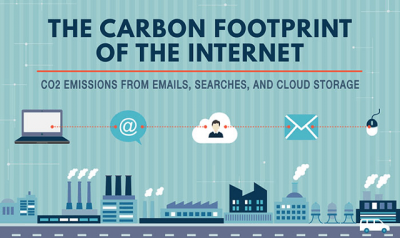Difference between revisions of "The Internet's Footprint"
(→How the internet has reduced environmental footprint) |
(→Limiting the Internet’s footprint) |
||
| Line 22: | Line 22: | ||
==Limiting the Internet’s footprint== | ==Limiting the Internet’s footprint== | ||
| − | There are several ways to reduce the internet footprint of individual internet users. Start by unplugging and shutting down computers and their devices when they are not in use to save energy. Putting a computer in sleep mode is advised if they are used often throughout the day. <ref> C. (2018, May 7). Infographic: The carbon footprint of the internet. Retrieved March 12, 2021, from https://www.climatecare.org/resources/news/infographic-carbon-footprint-internet/</ref> Then try to store your data on a [https://www.wired.com/story/amazon-google-microsoft-green-clouds-and-hyperscale-data-centers/| green cloud provider] that runs on renewable energy sources. Another small tip is to use smaller devices such as a phone or tablet instead of a large PC when doing quick research because they use less energy. <ref> C. (2018, May 7). Infographic: The carbon footprint of the internet. Retrieved March 12, 2021, from https://www.climatecare.org/resources/news/infographic-carbon-footprint-internet/</ref> | + | The emissions produced by the internet are estimated to double in the next five years. There are several ways to reduce the internet footprint of individual internet users. Start by unplugging and shutting down computers and their devices when they are not in use to save energy. Putting a computer in sleep mode is advised if they are used often throughout the day. <ref> C. (2018, May 7). Infographic: The carbon footprint of the internet. Retrieved March 12, 2021, from https://www.climatecare.org/resources/news/infographic-carbon-footprint-internet/</ref> Then try to store your data on a [https://www.wired.com/story/amazon-google-microsoft-green-clouds-and-hyperscale-data-centers/| green cloud provider] that runs on renewable energy sources. Another small tip is to use smaller devices such as a phone or tablet instead of a large PC when doing quick research because they use less energy. <ref> C. (2018, May 7). Infographic: The carbon footprint of the internet. Retrieved March 12, 2021, from https://www.climatecare.org/resources/news/infographic-carbon-footprint-internet/</ref> |
==Notes== | ==Notes== | ||
<References/> | <References/> | ||
Revision as of 16:51, 12 March 2021
An environmental footprint, also known as an ecological footprint, is a measurement of the effects a company, person or activity has on the environment. It is measured by considering the multiple impacts certain activities and industries have on water, land, air, carbon release, etc. [1] For example, ecologist will measure qualities such as the amount of waste produced or how many non-renewable resources used up to determine the environmental footprint it left on the planet. The Internet and it's digital technologies are believed to be accountable for 4% of greenhouse gas emissions.
Contents
How the Internet has reduced environmental footprint
The internet has reduced ecological footprints because it has limited conventional transaction activities that would harmfully impact the environment. The internet supplies online music streaming and music downloads to replace CDs and records which eliminates the waste of production of the tangible items. Applications like zoom and facetime can reduce the need to fly or drive to and from certain areas for face-to-face conversation. Technology and the internet have diminished the need for paper with digital alternatives to books, paying bills, and other traditionally printed necessities. This saves trees, energy, and other natural resources. Platforms like the internet and social media also make people more aware of the environmental footprints they leave and provide tips on how to reduce them.
How the Internet leaves a footprint
Measuring the Internet
Before calculating how much emissions the internet releases it is important to define what the internet is and what aspects of the internet come into account when measuring it’s footprint. This is why analysts and ecologists can only estimate how effective the internet is on the environment. According to Jon Koomey, author and researcher, the internet is made of three main components: end-user equipment, data centers, and access networks. [2]
End-user equipment
End-user equipment is any type of computing, communication, or display device that utilizes the internet. This includes laptops, tablets, phones, wireless routers, televisions, and monitors. There are over 1.6 billion connected devices in the world and each individual device uses carbon emissions from manufacturing. [3]Even though singular devices release less emissions, the amount of devices total can use up to 6.2% of the world's electricity from grids generated by coal, oil, and natural gas. [4]
Data centers
Data centers keep the internet running, but use up tons of electricity. They need a lot of power to cool IT equipment and power distribution to support their servers. [5] Data centers are supposed to save energy because they consolidate power used for computers while using less servers. However, the electricity used to power them is still using large amounts of non-renewable energy(coal and nuclear power stations) and are consequently polluting the planet. [6]
Access networks
Access networks include landline technologies, mobile data
Limiting the Internet’s footprint
The emissions produced by the internet are estimated to double in the next five years. There are several ways to reduce the internet footprint of individual internet users. Start by unplugging and shutting down computers and their devices when they are not in use to save energy. Putting a computer in sleep mode is advised if they are used often throughout the day. [7] Then try to store your data on a green cloud provider that runs on renewable energy sources. Another small tip is to use smaller devices such as a phone or tablet instead of a large PC when doing quick research because they use less energy. [8]
Notes
- ↑ Admin, L. (2019, August 13). What is an environmental Foot PRINT? (Ecological Footprint). Retrieved March 12, 2021, from https://lpelc.org/what-is-an-environmental-foot-print-ecological-footprint/
- ↑ Googlegreen (Director). (2013, June 07). "How green is the Internet?" summit: Internet Infrastructure | Jon Koomey [Video file]. Retrieved March 12, 2021, from https://www.youtube.com/watch?v=O8-LDLyKaBM
- ↑ Googlegreen (Director). (2013, June 07). "How green is the Internet?" summit: Internet Infrastructure | Jon Koomey [Video file]. Retrieved March 12, 2021, from https://www.youtube.com/watch?v=O8-LDLyKaBM
- ↑ C. (2018, May 7). Infographic: The carbon footprint of the internet. Retrieved March 12, 2021, from https://www.climatecare.org/resources/news/infographic-carbon-footprint-internet/
- ↑ Googlegreen (Director). (2013, June 07). "How green is the Internet?" summit: Internet Infrastructure | Jon Koomey [Video file]. Retrieved March 12, 2021, from https://www.youtube.com/watch?v=O8-LDLyKaBM
- ↑ Hurst, M. (2017, September 05). How polluting is the internet? Retrieved March 12, 2021, from http://lab.cccb.org/en/how-polluting-is-the-internet/
- ↑ C. (2018, May 7). Infographic: The carbon footprint of the internet. Retrieved March 12, 2021, from https://www.climatecare.org/resources/news/infographic-carbon-footprint-internet/
- ↑ C. (2018, May 7). Infographic: The carbon footprint of the internet. Retrieved March 12, 2021, from https://www.climatecare.org/resources/news/infographic-carbon-footprint-internet/

